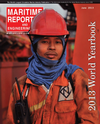
Page 25: of Maritime Reporter Magazine (June 2013)
Annual World Yearbook
Read this page in Pdf, Flash or Html5 edition of June 2013 Maritime Reporter Magazine
www.marinelink.com 25Loading (STL) Buoys and Icebreaking Offshore Facilities exist. Tunnel Boring Machines (TBM?s) can tunnel the sub- sea ß oor, eliminating many environmen- tal impacts, and, the development can be done at a considerably lower cost than a $70 billion dollar large-diameter line proposed from the North Slope to Valdez or Anchorage.In October 2012, The TransCanada Corporation proposed a rerouted project to Anchorage and detailed it to Alaska?s Governor Parnell. The update reportedly claims it will cost about $70 billion for a North Slope gas treatment, conditioning plants, and 800-mile pipeline to South-central Alaska including a LNG storage facility and tanker terminal to export 15 to 18 million metric tons of LNG annu-ally. The 800-mile pipeline is only one el-ement of total cost, as an over the life of the pipeline to a southern tidewater, numerous costs will be imposed: A per mile fee for maintenance, remediation, etc., will be paid to the pipeline?s owners as rent for the line and all that will far exceed the cost anything anticipated for a three to Þ ve mile sub-sea ß oor pipeline to Arctic tidewater. In every scenario, ships must be built. A Q-max sized LNG ship at 1132 x 177 ft. carries about 266,000 cu. m. tons of LNG and costs $200-300 million to build To export LNG from the North Slope, 10 to 15 purpose-built ships must be constructed for between $2b and 4.5b. Even with that cost added to the North Slope export facilities, the esti-mated development should be $50b less than crossing Alaska to Anchorage, and the timeline is compressed.Most importantly for Alaskans, the dif- ferential capital cost between proposed pipelines going south, plus facilities and ships and, TASR North Slope LNG ex- port will be signiÞ cant. On the surface it is $50b, ample capital to fund both in-state domestic gas heating distribu-tion systems as well as, a full spectrum of in-state industrial developments when practical and proÞ table. So, does the TASR development bene- Þ t Alaskans more than 800-mile pipeline south? In a word, yes. Alaska?s leaders say Alaska?s resources belong to ?us,? the people. However in reality, Alaska?s resources belong to the State and the State is mandated to manage them for the highest beneÞ t of the Alaskan peo- ple. If that is correct, then producing re-source revenues for less cost on a shorter schedule brings the highest beneÞ t.MR #6 (18-25).indd 25MR #6 (18-25).indd 255/30/2013 12:11:55 PM5/30/2013 12:11:55 PM

 24
24

 26
26
